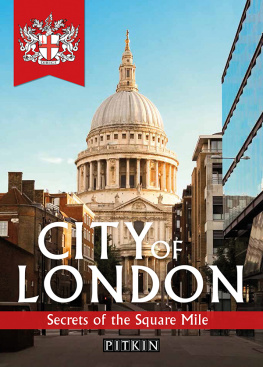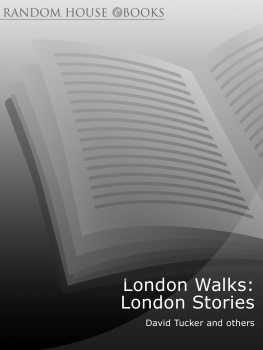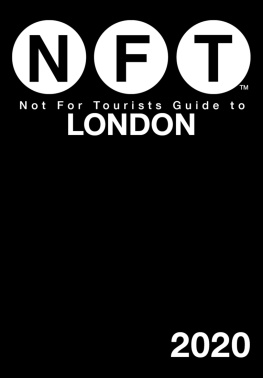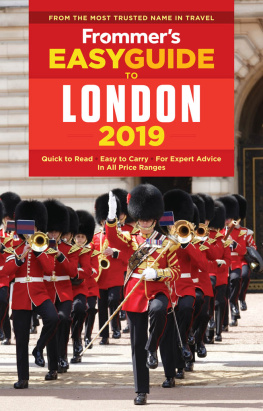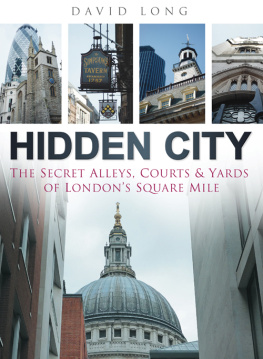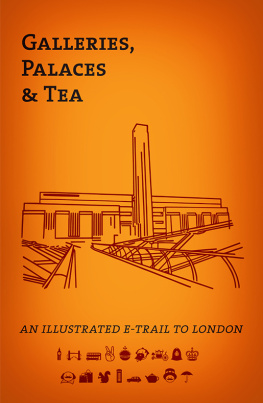Contents
Guide
CONTENTS

THE SQUARE MILE
We can thank the Romans for founding the City of London, naming it Londinium, and for its descriptive nickname of The Square Mile. The initial Roman settlement, which was founded around AD 43, didnt last long and was burned to the ground by Boudicca, the warrior queen, in about AD 60.
DID YOU KNOW?
The City is full of historical firsts and oldests, including the oldest continuously inhabited room, which is in the hall of the Vintners Company and predates the Great Fire of London. It has the oldest continuous system of government in the UK, was the first city to elect its own Chief Magistrate and is the place where organisations, including the Samaritans and the Methodist Church, were first established.
The Romans learned the lessons of this native rebellion and erected a wall around the new trading port on the north bank of the Thames. It was approximately one Roman square mile (1,000 paces or 5,000 feet). However, this was never square it was an irregularly shaped area that followed the line of the river as its southern boundary.
London covers 600 square miles and has a population of 8.6 million, but only its oldest part, just one square mile in size, is called the City of London. The City of London (the City) has expanded slightly over the centuries and now encompasses an area of 1.2 modern square miles (3.11 square kilometres), and yet it retains its essential character and identity as the most ancient part of the greater metropolis we now call London; the City of London is very much a distinct city within a city.

The City skyline and Blackfriars Bridge at sunrise.
DID YOU KNOW?
The City blends the ancient and the modern seamlessly. While the City has the greatest concentration of financial and professional services businesses in the world, it is also home to the College of Arms, which is a branch of the Royal Household responsible for granting and regulating the use of coats of arms in much of the Commonwealth.
The settlement achieved a population of 60,000 just 40 years after its foundation and became the largest city north of the Alps. The ravages of the plague in the early middle ages are estimated to have killed one in three of the population and plague pits have been revealed during recent excavations for the new Crossrail.
The Great Fire of London in 1666 is the most famous of the many fires that engulfed parts of the City. The fire raged for five days and is estimated to have consumed 13,200 houses, as well as St Pauls Cathedral, 87 churches, six chapels, Guildhall, the Royal Exchange, the Custom House, numerous livery company halls, three gates and four stone bridges. Sir Christopher Wrens plans for the design of a new metropolis of wide open streets wasnt to be, as land owners wanted to regain the land they owned in the City prior to the fire. As a result the Citys street layout is still essentially medieval in origin.
The Second World War bombing, widely known as the Blitz, resulted in the destruction of much of the ancient City, including many of the Livery Halls and the roof of Guildhall. St Pauls was hit but survived thanks to the efforts of the Fire Watch. Other densely packed areas such as the Barbican were reduced to rubble and not fully redeveloped until the 1970s.
Deregulation of the financial markets in 1986, otherwise described as the Big Bang, heralded the advent of computer-based trading and the influx of American and other foreign firms into the Square Mile. It set the City on the path to becoming the worlds largest financial services centre, surpassing New York.
The residential population of the City in modern times is only about 7,000, yet more than 400,000 people commute into the City during the working week. During business hours the City is a hive of commercial activity; it is the most economically prosperous and productive part of the UK, and a global hub for financial and professional services. Despite this, at the weekends and away from the tourist hot spots, the City can seem almost abandoned.
The City has its own unique system of government, its own police force and its own civil and criminal courts. It is not a borough of Greater London; rather it is a ceremonial county, the smallest in the UK, with its own elected Sheriffs and, most importantly, its Lord Mayor who should never be confused with the Mayor of London.
DID YOU KNOW?
Ten of the main entrances to the City of London, including London and Blackfriars bridges, are marked by statues of dragons, legendary creatures which support the shield in the Citys coat of arms. The dragon shown right is one of a pair on Victoria Embankment opposite Temple. They originally stood outside the Coal Exchange until it was demolished in 1963. The other dragons are smaller replicas of these originals.
The Citys government is one in which residents, businesses and members of the Citys guilds (known as Livery Companies) all participate in voting. The Sheriffs are elected by the Liverymen of the Citys guilds and the candidates for Lord Mayor are approved by them before being elected.
The Court of Common Council predates parliament and has the power to amend its own constitution, a privilege not granted to any other city, town or other local government in the UK. It is also the only city mentioned by name in Magna Carta; a clause still in effect today confirms the Citys ancient rights and privileges that already existed long before that famous document was written. In fact, the Citys government is so ancient that it has no founding document or constitution; it exists by prescription.

The Citys modern skyscrapers, including the Walkie Talkie, the Cheesegrater and the Gherkin.
DID YOU KNOW?
The City of London is the centre of global foreign exchange dealing. In 2017 over 40 per cent of all the worlds foreign exchange transactions were made in the City, a total of $2.7 trillion per day.

One of the original City of London dragons that marked the entrance to the City.
It is because of the ancient and unique nature of the Square Mile, rather than in spite of it, that the City is able to blend the past with the present so successfully. In 2017 the venture capital investment in the Citys technology services businesses reached a record 2.5 billion, a figure four times larger than Paris, its nearest European rival. In the same year, the City elected the 690th Lord Mayor of London in what is possibly the oldest, continuous civic ceremony in the UK.
The Square Mile has always been a place of commerce, where merchants traded, craftsmen toiled, financiers lent money and taxes were collected. In the 21st century, the Citys businesses are largely focussed on financial, professional and technology-based services, including banking, insurance, investment, commodities trading, marketing, legal services, information technology, telecommunications and all the facets of the globalised information economy.

